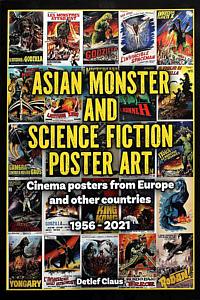and the US ever since the 1950s have drawn audiences to the cinemas. With the dawn of the atomic age and space exploration, also science fiction films quickly established as a genre.

To promote such films made in Asia worldwide, and to keep national movie distributors curious, lobby cards and film stills would be sent ahead of the films, to stir interest in the productions.
The final large-scale movie posters, however, from the 1950s to roughly the 1970s, in each country were created individually. To show the diversity and domestic creativity of that promotional material is the theme of Asian Monster and Science Fiction Poster Art.
This bilingual (German/English) over-sized book is the third large presentation of visual works introduced by German author Detlef Claus. This collector of Godzilla and Asian monster memorabilia five decades ago when still a teenager decided to amass anything related to the movie monsters, especially film stills and cinema poster art. The former projectionist for a number of movie theaters is a world-renowned expert on Japanese science-fiction films and anything kaiju movie related. His huge collection, more than 50 years in the making, contains vintage movie posters from 25 countries. His vault is probably the largest of its kind, at least in Europe. It holds thousands of pieces. Several items from his vault are unique and priceless.
The hefty 352 page edition at hand covers a small selection of Japanese science-fiction films and monster movies released between 1954 and 2021, i.e. their respective domestic promotional poster material and lobby cards intended for display at the box office. In that respect, it differs strongly from the author’s 2011 self-published German title Asiatische Monster und Science Fiction Filme. Das deutsche Werbematerial von 1956 – 2011 (Asian Monster and Science Fiction Movies. German Advertising Material) that contained German posters exclusively.
The limited edition 2023 Monster and Science Fiction Poster Art book is focused on the international perspective of movie promotion material, as here Claus displays diverse movie poster designs from various countries, although mostly European artwork is used. The respective posters from Italy, Spain, Belgium, Turkey, France, Poland, Thailand and other countries often differ strongly from each other and from the style of the original Japanese movie poster, as all selected films (around 60), were first shown in Japan, to be exported abroad either shortly afterwards or decades later. Each title under inspection is lavishly illustrated on up to six pages with pictures, showing the respective domestic artwork. The volume contains roughly 1,000 first-generation reproductions of the original vintage film posters from the author’s collection on photo paper.
Each poster is a little gem. Since until the 1960s/1970s, most movie posters were hand-painted by artists, collages appeared somewhat later, and there was no digital copying or illustrating. For example, the 1966 film Ebirah, Horror of the Deep was advertised in very different manners and used varying film action scenes for promotion in Italy, Mexico, France and Poland. Simply because film distributors let the respective national cinemas decide what promotional material to use and did not prohibit them from producing their own posters. (Sometimes exhibiting features, characters, action scenes, battles and even monsters entirely absent from the movies, to draw crowds to the theaters.)
As many of these posters are very rare and often reveal beautiful works of (cinematic) art, exploring the book is a pure pleasure. The range here covers a variety of Godzilla movies, science fiction pictures, King Kong sequels and other monster films. It is a blend of classics and hard-to-find releases such as The Return of Godzilla, Yongary Monster of the Deep, Latitude Zero, Water Cyborg, Atragon, The H-Man, Godzilla vs. The Thing, Frankenstein Conquers the World, The X From Outer Space, The Mysterians, The War in Space and others.
Each title is introduced with a short synopsis. Interestingly, several films that promised great action were exported to just a few countries; some never made it to the majority of European theaters, sometimes there simply was a lack of interest. Others, however, were successfully exported only briefly after their premiere in Japan, to be shown repeatedly throughout the years. At many occasions with newly designed movie posters for the same country with every re-release.
Much of the poster art assembled here has never been printed in a book before. Several posters on display were not even used, as distributors decided against certain movies, and finished posters vanished into obscurity or on forgotten shelves, only to be discovered and collected by the author over the decades. Asian Monster and Science Fiction Poster Art is a very entertaining coffee-table book that easily transports the magic of two old movie genres that have been around for 70 years and its respective poster art into the present.
Review by Dr. A. Ebert © 2023
Detlef Claus. Asian Monster and Science Fiction Poster Art. Cinema posters from Europe and other countries 1956 – 2021. Published by the author, 2023, 352 p.
